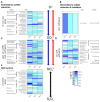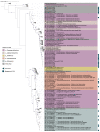Distribution and Activity of Sulfur-Metabolizing Bacteria along the Temperature Gradient in Phototrophic Mats of the Chilean Hot Spring Porcelana
- PMID: 37512975
- PMCID: PMC10385741
- DOI: 10.3390/microorganisms11071803
Distribution and Activity of Sulfur-Metabolizing Bacteria along the Temperature Gradient in Phototrophic Mats of the Chilean Hot Spring Porcelana
Abstract
In terrestrial hot springs, some members of the microbial mat community utilize sulfur chemical species for reduction and oxidization metabolism. In this study, the diversity and activity of sulfur-metabolizing bacteria were evaluated along a temperature gradient (48-69 °C) in non-acidic phototrophic mats of the Porcelana hot spring (Northern Patagonia, Chile) using complementary meta-omic methodologies and specific amplification of the aprA (APS reductase) and soxB (thiosulfohydrolase) genes. Overall, the key players in sulfur metabolism varied mostly in abundance along the temperature gradient, which is relevant for evaluating the possible implications of microorganisms associated with sulfur cycling under the current global climate change scenario. Our results strongly suggest that sulfate reduction occurs throughout the whole temperature gradient, being supported by different taxa depending on temperature. Assimilative sulfate reduction is the most relevant pathway in terms of taxonomic abundance and activity, whereas the sulfur-oxidizing system (Sox) is likely to be more diverse at low rather than at high temperatures. Members of the phylum Chloroflexota showed higher sulfur cycle-related transcriptional activity at 66 °C, with a potential contribution to sulfate reduction and oxidation to thiosulfate. In contrast, at the lowest temperature (48 °C), Burkholderiales and Acetobacterales (both Pseudomonadota, also known as Proteobacteria) showed a higher contribution to dissimilative sulfate reduction/oxidation as well as to thiosulfate metabolism. Cyanobacteriota and Planctomycetota were especially active in assimilatory sulfate reduction. Analysis of the aprA and soxB genes pointed to members of the order Burkholderiales (Gammaproteobacteria) as the most dominant and active along the temperature gradient for these genes. Changes in the diversity and activity of different sulfur-metabolizing bacteria in photoautotrophic microbial mats along a temperature gradient revealed their important role in hot spring environments, especially the main primary producers (Chloroflexota/Cyanobacteriota) and diazotrophs (Cyanobacteriota), showing that carbon, nitrogen, and sulfur cycles are highly linked in these extreme systems.
Keywords: aprA; metagenomics; phototrophic hot spring mat; soxB; sulfur oxidation/reduction.
Conflict of interest statement
The authors declare no conflict of interest.
Figures





References
-
- Fike D.A., Bradley A.S., Rose C.V. Rethinking the Ancient Sulfur Cycle. Annu. Rev. Earth Planet. Sci. 2015;43:593–622. doi: 10.1146/annurev-earth-060313-054802. - DOI
-
- Tassi F., Aguilera F., Darrah T., Vaselli O., Capaccioni B., Poreda R., Huertas A.D. Fluid geochemistry of hydrothermal systems in the Arica-Parinacota, Tarapacá and Antofagasta regions (northern Chile) J. Volcanol. Geotherm. Res. 2010;192:1–15. doi: 10.1016/j.jvolgeores.2010.02.006. - DOI
-
- Nordstrom D.K., McCleskey R.B., Ball J.W. Sulfur geochemistry of hydrothermal waters in Yellowstone National Park: IV Acid-sulfate waters. Appl. Geochem. 2009;24:191–207. doi: 10.1016/j.apgeochem.2008.11.019. - DOI
-
- Canfield D.E., Kristensen E., Thamdrup B. The Sulfur Cycle. In: Canfield D.E., Kristensen E., Thamdrup B., editors. Advances in Marine Biology. Volume 48. Academic Press; Cambridge, MA, USA: 2005. pp. 313–381. - PubMed
Grants and funding
- Doctoral fellowship N° 21191763/Agencia Nacional de Investigación y Desarrollo
- Postdoctoral fellowship FONDECYT N° 3170807/Agencia Nacional de Investigación y Desarrollo
- FONDAP CR2 Nº 15110009/Agencia Nacional de Investigación y Desarrollo
- regular N° 1150171/Agencia Nacional de Investigación y Desarrollo
- regular N° 1190998/Agencia Nacional de Investigación y Desarrollo
LinkOut - more resources
Full Text Sources
Molecular Biology Databases
Miscellaneous

